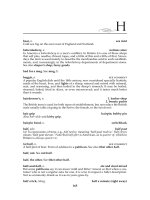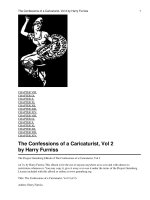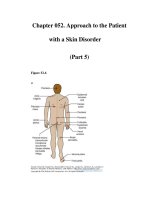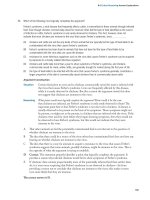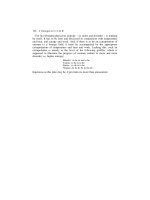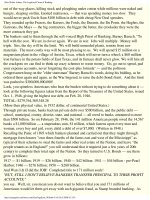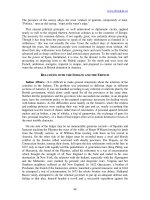The ocean bottom a region nearly 2.5 times
Bạn đang xem bản rút gọn của tài liệu. Xem và tải ngay bản đầy đủ của tài liệu tại đây (621.04 KB, 244 trang )
The ocean bottom a
region nearly 2.5 times
1995-2000 Reading Full Test
1995-08
Questions 1-9
The ocean bottom ------a region nearly 2.5 times greater than the total land area of the
Earth ---- is a vast frontier that even today is largely unexplored and uncharted. Until
about a century ago, the deep-ocean floor was completely inaccessible, hidden beneath
waters averaging over 3,600 meters deep. Totally without light and subjected to intense
pressures hundreds of times greater than at the Earth's surface, the deep-ocean bottom
is a hostile environment to humans, in some ways as forbidding and remote as the void
of outer space.
Although researchers have taken samples of deep-ocean rocks and sediments for
over a century, the first detailed global investigation of the ocean bottom did not
actually start until 1968, with the beginning of the National Science Foundation's Deep
Sea Drilling Project (DSDP).Using techniques first developed for the offshore oil and
gas industry, the DSDP's drill ship, the Glomar Challenger, was able to maintain a
steady position on the ocean's surface and drill in very deep waters, extracting samples
of sediments and rock from the ocean floor.
The Glomar Challenger completed 96 voyages in a 15-year research program that
ended in November 1983. During this time, the vessel logged 600,000 kilometers and
took almost 20,000 core samples of seabed sediments and rocks at 624 drilling sites
around the world. The Glomar Challenger's core samples have allowed geologists
to reconstruct what the planet looked like hundred of millions of years ago and to
calculate what it will probably look like millions of years in the future. Today, largely
on the strength of evidence gathered during the Glomar Challenger's voyages, nearly
all earth scientists agree on the theories of plate tectonics and continental drift that
explain many of the geological processes that shape the Earth.
The cores of sediment drilled by the Glomar Challenger have also yielded
information critical to understanding the world's past climates. Deep-ocean sediments
provide a climatic record stretching back hundreds of millions of years, because they
are largely isolated from the mechanical erosion and the intense chemical and biological
activity that rapidly destroy much land-based evidence of past climates. This record has
already provided insights into the patterns and causes of past climatic change --information that may be used to predict future climates.
1.The author refers to the ocean bottom as a "frontier" in line 2 because it
(A)is not a popular area for scientific research
(B)contains a wide variety of life forms
(C)attracts courageous explorers
(D)is an unknown territory
2.The word "inaccessible" in line 3 is closest in meaning to
(A)unrecognizable
1
(B)unreachable
(C)unusable
(D)unsafe
3.The author mentions outer space in line 7 because
(A)the Earth's climate millions of years ago was similar to conditions in outer space.
(B)it is similar to the ocean floor in being alien to the human environment
(C)rock formations in outer space are similar to those found on the ocean floor
(D)techniques used by scientists to explore outer space were similar to those used in ocean
exploration
4. Which of the following is true of the Glomar Challenger?
(A) It is a type of submarine.
(B) It is an ongoing project.
(C) It has gone on over 100 voyages
(D) It made its first DSDP voyage in 1968
5. The word " extracting " in line 13 is closest in meaning to
(A) breaking
(B) locating
(C) removing
(D) analyzing
6. The deep Sea Drilling Project was significant because it was
(A) an attempt to find new sources of oil and gas
(B) the first extensive exploration of the ocean bottom
(C) composed of geologists form all over the world
(D) funded entirely by the gas and oil industry
7. The word " strength " in line21 is closest in meaning to
(A)basis
(B)purpose
(C)discovery
(D)endurance
8.The word " they " in line26 refers to
(A)years
(B)climates
(C)sediments
(D)cores
9.Which of the following is NOT mentioned in the passage as being a result of the Deep Sea
Drilling Project?
(A) Geologists were able to determine the Earth's appearance hundreds of millions of years ago.
(B) Two geological theories became more widely accepted
(C) Information was revealed about the Earth's past climatic changes.
(D) Geologists observed forms of marine life never before seen.
Question 10-21
Basic to any understanding of Canada in the 20 years after the Second World War is
the country's impressive population growth. For every three Canadians in 1945, there
2
were over five in 1966. In September 1966 Canada's population passed the 20 million
mark. Most of this surging growth came from natural increase. The depression of the
1930's and the war had held back marriages, and the catching-up process began after
1945. The baby boom continued through the decade of the1950's, producing a
population increase of nearly fifteen percent in the five years from 1951 to 1956. This
rate of increase had been exceeded only once before in Canada's history, in the decade
before 1911. when the prairies were being settled. Undoubtedly, the good economic
conditions of the 1950's supported a growth in the population, but the expansion also
derived from a trend toward earlier marriages and an increase in the average size of
families. In 1957 the Canadian birth rate stood at 28 per thousand, one of the highest in
the world.
After the peak year of 1957, the birth rate in Canada began to decline. It continued
falling until in 1966 it stood at the lowest level in 25 years. Partly this decline reflected
the low level of births during the depression and the war, but it was also caused by
changes in Canadian society. Young people were staying at school longer; more
women were working; young married couples were buying automobiles or houses
before starting families; rising living standards were cutting down the size of families.
It appeared that Canada was once more falling in step with the trend toward smaller
families that had occurred all through the Western world since the time of the Industrial
Revolution.
Although the growth in Canada's population had slowed down by 1966 (the
increase in the first half of the 1960's was only nine percent), another large population
wave was coming over the horizon. It would be composed of the children
who were born during the period of the high birth rate prior to 1957.
10. What does the passage mainly discuss?
(A) Educational changes in Canadian society
(B) Canada during the Second World War
(C) Population trends in postwar Canada
(D) Standards of living in Canada
11. According to the passage, when did Canada's baby boom begin?
(A) In the decade after 1911
(B) After 1945
(C) During the depression of the 1930's
(D) In 1966
12. The word "five" in line 3 refers to
(A) Canadians
(B) years
(C) decades
(D) marriages
13. The word "surging" in line 4 is closest in meaning to
(A) new
(B) extra
(C) accelerating
3
(D) surprising
14. The author suggests that in Canada during the1950's
(A) the urban population decreased rapidly
(B) fewer people married
(C) economic conditions were poor
(D) the birth rate was very high
15. The word "trend" in line 11 is closest in meaning to
(A) tendency
(B) aim
(C) growth
(D) directive
16. The word "peak" in line 14 is closest in meaning to
(A) pointed
(B) dismal
(C) mountain
(D) maximum
17. When was the birth rate in Canada at its lowest postwar level?
(A) 1966
(B) 1957
(C) 1956
(D) 1951
18. The author mentions all of the following as causes of declines in population growth after 1957
EXCEPT
(A) people being better educated
(B) people getting married earlier
(C) better standards of living
(D) couples buying houses
19. It can be inferred from the passage that before the Industrial Revolution
(A) families were larger
(B) population statistics were unreliable
(C) the population grew steadily
(D) economic conditions were bad
20. The word "It" in line 25 refers to
(A) horizon
(B) population wave
(C) nine percent
(D) first half
21. The phrase "prior to" in line 26 is closest in meaning to
(A) behind
(B) since
(C) during
(D) preceding
Questions 22-30
4
Are organically grown foods the best food choices? The advantages claimed for
such foods over conventionally grown and marketed food products are now being
debated. Advocates of organic foods ----- a term whose meaning varies greatly --frequently proclaim that such products are safer and more nutritious than others.
The growing interest of consumers in the safety and nutritional quality of the
typical North American diet is a welcome development. However, much of this
interest has been sparked by sweeping claims that the food supply is unsafe or
inadequate in meeting nutritional needs. Although most of these claims are not
supported by scientific evidence, the preponderance of written material advancing
such claims makes it difficult for the general public to separate fact from fiction.
As a result, claims that eating a diet consisting entirely of organically grown foods
prevents or cures disease or provides other benefits to health have become widely
publicized and form the basis for folklore.
Almost daily the public is besieged by claims for "no-aging" diets, new vitamins,
and other wonder foods. There are numerous unsubstantiated reports that natural
vitamins are superior to synthetic ones, that fertilized eggs are nutritionally superior
to unfertilized eggs, that untreated grains are better than fumigated grains, and the like.
One thing that most organically grown food products seem to have in common is
that they cost more than conventionally grown foods. But in many cases consumers are
misled if they believe organic foods can maintain health and provide better nutritional
quality than conventionally grown foods. So there is real cause for concern if consumers,
particularly those with limited incomes, distrust the regular food supply and buy only
expensive organic foods instead.
22. The word "Advocates" in line 3 is closest in meaning to which of the following?
(A) Proponents
(B) Merchants
(C) Inspectors
(D) Consumers
23. In line 4, the word "others" refers to
(A) advantages
(B) advocates
(C) organic foods
(D) products
24. The "welcome development" mentioned in line 6 is an increase in
(A) interest in food safety and nutrition among North Americans
(B) the nutritional quality of the typical North American diet
(C) the amount of healthy food grown in North America
(D) the number of consumers in North America
25. According to the first paragraph, which of the following is true about the term "organic foods"?
(A) It is accepted by most nutritionists.
(B) It has been used only in recent years.
(C) It has no fixed meaning.
(D) It is seldom used by consumers.
5
26. The word "unsubstantiated" in line 15 is closest in meaning to
(A) unbelievable
(B) uncontested
(C) unpopular
(D) unverified
27. The word "maintain" in line 20 is closest in meaning to
(A) improve
(B) monitor
(C) preserve
(D) restore
28. The author implies that there is cause for concern if consumers with limited incomes buy
organic foods instead of conventionally grown foods because
(A) organic foods can he more expensive but are often no better than conventionally grown foods
(B) many organic foods are actually less nutritious than similar conventionally grown foods
(C) conventionally grown foods are more readily available than organic foods
(D) too many farmers will stop using conventional methods to grow food crops
29. According to the last paragraph, consumers who believe that organic foods are better than
conventionally grown foods are often
(A) careless
(B) mistaken
(C) thrifty
(D) wealthy
30. What is the author's attitude toward the claims made by advocates of health foods?
(A) Very enthusiastic
(B) Somewhat favorable
(C) Neutral
(D) Skeptical
Questions 31-40
There are many theories about the beginning of drama in ancient Greece. The one
most widely accepted today is based on the assumption that drama evolved from ritual.
The argument for this view goes as follows. In the beginning, human beings viewed
the natural forces of the world, even the seasonal changes, as unpredictable, and they
sought, through various means, to control these unknown and feared powers. Those
measures which appeared to bring the desired results were then retained and repeated
until they hardened into fixed rituals. Eventually stories arose which explained or
veiled the mysteries of the rites. As time passed some rituals were abandoned, but
the stories, later called myths, persisted and provided material for art and drama.
Those who believe that drama evolved out of ritual also argue that those rites
contained the seed of theater because music, dance, masks, and costumes were almost
always used. Furthermore, a suitable site had to be provided for performances, and
when the entire community did not participate, a clear division was usually made
between the "acting area" and the "auditorium". In addition, there were performers,
and, since considerable importance was attached to avoiding mistakes in the enactment
6
of rites, religious leaders usually assumed that task. Wearing masks and costumes, they
often impersonated other people, animals, or supernatural beings, and mimed the desired
effect --- success in hunt or battle, the coming rain, the revival of the Sun --- as an actor
might. Eventually such dramatic representations were separated from religious
activities.
Another theory traces the theater's origin from the human interest in storytelling.
According to this view, tales (about the hunt, war, or other feats) are gradually
elaborated, at first through the use of impersonation, action, and dialogue by a narrator
and then through the assumption of each of the roles by a different person. A closely
related theory traces theater to those dances that are primarily rhythmical and
gymnastic or that are imitations of animal movements and sounds.
31.What does the passage mainly discuss?
(A) The origins of theater
(B) The role of ritual in modern dance
(C) The importance of storytelling
(D) The variety of early religious activities
32.The word "they" in line 4 refers to
(A) seasonal changes
(B) natural forces
(C) theories
(D) human beings
33. What aspect of drama does the author discuss in the first paragraph?
(A) The reason drama is often unpredictable
(B) The seasons in which dramas were performed
(C) The connection between myths and dramatic plots
(D) The importance of costumes in early drama
34. Which of the following is NOT mentioned as a common element of theater and ritual?
(A) Dance
(B) Costumes
(C) Music
(D) Magic
35. The word "considerable" in line 15 is closest in meaning to
(A) thoughtful
(B) substantial
(C) relational
(D) ceremonial
36. The word "enactment" in line 15 is closest in meaning to
(A) establishment
(B) performance
(C) authorization
(D) season
37. The word "they" in line 16 refers to
(A) mistakes
7
(B) costumes
(C) animals
(D) performers
38. According to the passage, what is the main difference between ritual and drama?
(A) Ritual uses music whereas drama does not.
(B) Ritual is shorter than drama.
(C) Ritual requires fewer performers than drama.
(D) Ritual has a religious purpose and drama does not.
39. The passage supports which of the following statements?
(A) No one really knows how the theater began.
(B) Myths are no longer represented dramatically.
(C) Storytelling is an important part of dance.
(D) Dramatic activities require the use of costumes.
40. Where in the passage does the author discuss the separation of the stage and the audience?
(A) Lines 8-9
(B) Lines 12-14
(C) Lines 19-20
(D) Lines 22-24
Questions 41-50
Staggering tasks confronted the people of the United States, North and South, when
the Civil War ended. About a million and a half soldiers from both sides had to be
demobilized, readjusted to civilian life, and reabsorbed by the devastated economy.
Civil government also had to be put back on a peacetime basis and interference from
the military had to be stopped.
The desperate plight of the South has eclipsed the fact that reconstruction had to be
undertaken also in the North, though less spectacularly. Industries had to adjust to
peacetime conditions: factories had to be retooled for civilian needs.
Financial problems loomed large in both the North and the South. The national debt
had shot up from a modest $65 million in 1861, the year the war started, to nearly $3
billion in 1865, the year the war ended. This was a colossal sum for those days but one
that a prudent government could pay. At the same time, war taxes had to be reduced to
less burdensome levels.
Physical devastation caused by invading armies, chiefly in the South and border
states, had to be repaired. This herculean task was ultimately completed, but with
discouraging slowness.
Other important questions needed answering. What would be the future of the four
million Black people who were freed from slavery? On what basis were the Southern
states to be brought back into the Union?
What of the Southern leaders, all of whom were liable to charges of treason? One
of these leaders, Jefferson Davis, president of the Southern Confederacy, was the
subject of an insulting popular Northern song,"Hang Jeff Davis from a Sour Apple
Tree", and even children sang it. Davis was temporarily chained in his prison cell
during the early days of his two-year imprisonment. But he and the other Southern
8
leaders were finally released, partly because it was unlikely that a jury from Virginia, a
Southern Confederate state, would convict them. All the leaders were finally pardoned
by President Johnson in 1868 in an effort to help reconstruction efforts proceed with as
little bitterness as possible.
41. What does the passage mainly discuss?
(A) Wartime expenditures
(B) Problems facing the United States after the war
(C) Methods of repairing the damage caused by the war
(D) The results of government efforts to revive the economy
42. The word "Staggering" in line 1 is closest in meaning to
(A) specialized
(B) confusing
(C) various
(D) overwhelming
43. The word "devastated" in line 3 is closest in meaning to
(A) developing
(B) ruined
(C) complicated
(D) fragile
44 According to the passage, which of the following statements about the damage in the South is
correct?
(A) It was worse than in the North.
(B) The cost was less than expected.
(C) It was centered in the border states.
(D) It was remedied rather quickly.
45. The passage refers to all of the following as necessary steps following the Civil War EXCEPT
(A) helping soldiers readjust
(B) restructuring industry
(C) returning government to normal
(D) increasing taxes
46. The word "task" in line 15 refers to
(A) raising the tax level
(B) sensible financial choices
(C) wise decisions about former slaves
(D) reconstruction of damaged areas
47. Why does the author mention a popular song in lines 22-23?
(A) To give an example of a Northern attitude towards the South
(B) To illustrate the Northern love of music
(C) To emphasize the cultural differences between the North and the South
(D) To compare the Northern and Southern presidents
48. The word "them" in line 26 refers to
(A) charges
(B) leaders
9
(C) days
(D) irons
49. Which of the following can be inferred from the phrase "...it was unlikely that a jury from
Virginia, a Southern Confederate state, would convict them" (lines 25-26)?
(A) Virginians felt betrayed by Jefferson Davis.
(B) A popular song insulted Virginia.
(C) Virginians were loyal to their leaders.
(D) All of the Virginia military leaders had been put in chains.
50. It can be inferred from the passage that President Johnson pardoned the Southern leaders in
order to
(A) raise money for the North
(B) repair the physical damage in the South
(C) prevent Northern leaders from punishing more Southerners
(D) help the nation recover from the war
1995-10
Questions 1-13
Atmospheric pressure can support a column of water up to 10 meters high. But
plants can move water much higher, the sequoia tree can pump water to its very top,
more than 100 meters above the ground. Until the end of the nineteenth century, the
movement of water's in trees and other talls plants was a mystery. Some botanists
hypothesized that the living cells of plants acted as pumps, but many experiments
demonstrated that the stems of plants in which all the cells are killed can still move
water to appreciable heights. Other explanations for the movement of water in plants
have been based on root pressure, a push on the water from the roots at the bottom of
the plant. But root pressure is not nearly great enough to push water to the tops of tall
trees, Furthermore, the conifers, which are among the tallest trees have unusually low
root pressures.
If water is not pumped to the top of a tall tree, and if it is not pushed, to the top of a
tall tree, then we may ask. How does it get there? According to the currently accepted
cohesion-tension theory, water is pulled there. The pull on a rising column of water in a
plant results from the evaporation of water at the top of the plant. As water is lost from
the surface of the leaves, a negative pressure or tension is created. The evaporated
water is replaced by water moving from inside the plant in unbroken columns that
extend from the top of a plant to its roots. The same forces that create surface tension
in any sample of water are responsible for the maintenance of these unbroken columns
of water. When water is confined in tubes of very small bore, the forces of cohesion
( the attraction between water molecules) are so great that the strength of a column of
water compares with the strength of a steel wire of the same diameter. This cohesive
strength permits columns of water to be pulled to great heights without being broken.
1. How many theories does the author mention?
(A) One
10
(B) Two
(C) Three
(D) Four
2. The passage answers which of the following questions ?
(A) What is the effect of atmospheric pressure on foliage?
(B) When do dead cells harm plant growth?
(C) How does water get to the tops of trees?
(D) Why is root pressure weak?
3. The word "demonstrated" in line 6 is closest in meaning to
(A) ignored
(B) showed
(C) disguised
(D) distinguished
4. What do the experiments mentioned in lines 6-8 prove?
(A) Plant stems die when deprived of water.
(B) Cells in plant sterns do not pump water.
(C) Plants cannot move water to high altitudes.
(D) Plant cells regulate pressure within stems.
5. How do botanists know that root pressure is not the only force that moves water in plants?
(A) Some very tall trees have weak root pressure.
(B) Root pressures decrease in winter.
(C) Plants can live after their roots die.
(D) Water in a plant's roots is not connected to water in its stem.
6. Which of the following statements does the passage support?
(A) Water is pushed to the tops of trees.
(B) Botanists have proven that living cells act as pumps.
(C) Atmospheric pressure draws water to the tops of tall trees.
(D) Botanists have changed their theories of how water moves in plants.
7. The word "it" in line 13 refers to
(A) top
(B) tree
(C) water
(D) cohesion-tension theory
8. The word "there" in line 15 refers to
(A) treetops
(B) roots
(C) water columns
(D) tubes
9. What causes the tension that draws water up a plant?
(A) Humidity
(B) Plant growth
(C) Root pressure
(D) Evaporation
10. The word "extend" in line 19 is closest in meaning to
11
(A) stretch
(B) branch
(C) increase
(D) rotate
11. According to the passage, why does water travel through plants in unbroken columns?
(A) Root pressure moves the water very rapidly.
(B) The attraction between water molecules is strong.
(C) The living cell of plants push the water molecules together.
(D) Atmospheric pressure supports the columns.
12. Why does the author mention steel wire in line 24?
(A) To illustrate another means of pulling water
(B) To demonstrate why wood is a good building material
(C) To indicate the size of a column of winter
(D) To emphasize the strength of cohesive forces in water
13. Where in the passage does the author give an example of a plant with low root pressure?
(A.) Lines 3-5
(B) Lines 6-8
(C) Lines 11-12
(D) Lines 13-14
Questions 14-22
Mass transportation revised the social and economic fabric of the American city
in three fundamental ways. It catalyzed physical expansion, it sorted out people and land
uses, and it accelerated the inherent instability of urban life. By opening vast areas of
unoccupied land for residential expansion, the omnibuses, horse railways, commuter
trains, and electric trolleys pulled settled regions outward two to four times more
distant from city centers than they were in the premodern era. In 1850, for example, the
borders of Boston lay scarcely two miles from the old business district by the turn of
the century the radius extended ten miles. Now those who could afford it could live far
removed from the old city center and still commute there for work, shopping, and
entertainment. The new accessibility of land around the periphery of almost every
major city sparked an explosion of real estate development and fulled what we now
know as urban sprawl. Between 1890 and 1920, for example, some 250,000 new
residential lots were recorded within the borders of Chicago, most of them located in
outlying areas. Over the same period, another 550,000 were plotted outside the city
limits but within the metropolitan area. Anxious to take advantage of the possibilities
of commuting, real estate developers added 800,000 potential building sites to the
Chicago region in just thirty years lots that could have housed five to six million
people.
Of course, many were never occupied; there was always a huge surplus of
subdivided, but vacant, land around Chicago and other cities. There excesses
underscore a feature of residential expansion related to the growth of mass
transportation urban sprawl was essentially unplanned. It was carried out by
thousands of small investors who paid little heed to coordinated land use or to future
12
land users. Those who purchased and prepared land for residential purposes,
particularly and near or outside city borders where transit lines and middle-class
inhabitants were anticipated, did so to create demand as much as to respond to it.
Chicago is a prime example of this process. Real estate subdivision there proceeded
much faster than population growth.
14. With which of the following subjects is the passage mainly concerned?
(A) Types of mass transportation
(B) Instability of urban life
(C) How supply and demand determine land use
(D) The effects of mass trans- city portation on urban expansion
15. The author mentions all of the following as effects of mass transportation on cities EXCEPT
(A) growth in city area
(B) separation of commercial and residential districts
(C) changes in life in the inner city
(D) increasing standards of living.
16. The word "vast" in line 4 is closest in meaning to
(A) large
(B) basic
(C) new
(D) urban
17. The word "sparked" in line 12 is closest in meaning to
(A) brought about
(B) surrounded
(C) sent out
(D) followed
18. Why does the author mention both Boston and Chicago?
(A)To demonstrate positive and negative effects of growth
(B) To show that mass transit changed many cities
(C) To exemplify cities with and without mass transportation
(D) To contrast their rates of growth
19. The word "potential" in line 18 is closest in meaning to
(A) certain
(B) popular
(C) improved
(D) possible
20.The word "many" in line 21 refers to
(A) people
(B) lots(C) years
(D) developers
21.According to the passage, what was one disadvantage of residential expansion?
(A) It was expensive.
(B) It happened too slowly.
13
(C) It was unplanned.
(D) It created a demand for public transportation.
22.The author mentions Chicago in the second paragraph as an example of a city
(A) that is large
(B) that is used as a model for land development
(C) where land development exceeded population growth
(D) with an excellent mass transportation system
Questions 23-33
The preservation of embryos and juveniles is a rare occurrence in the fossil record.
The tiny, delicate skeletons are usually scattered by scavengers or destroyed by
weathering before they can be fossilized. Ichthyosaurs had a higher chance of being
preserved than did terrestrial creatures because, as marine animals, they tended to live
in environments less subject to erosion. Still, their fossilization required a suite
of factors: a slow rate of decay of soft tissues, little scavenging by other animals, a lack
of swift currents and waves to jumble and carry away small bones, and fairly rapid
burial. Given these factors, some areas have become a treasury of well-preserved
ichthyosaur fossils.
The deposits at Holzmaden, Germany, present an interesting case for analysis. The
ichthyosaur remains are found in black , bituminous marine shales deposited about
190 million years ago. Over the years, thousands of specimens of marine reptiles, fish,
and invertebrates have been recovered from these rocks. The quality of preservation is
outstanding, but what is even more impressive is the number of ichthyosaur fossils
containing preserved embryos. Ichthyosaurs with embryos have been reported from 6
different levels of the shale in a small area around Holzmaden, suggesting that a
specific site was used by large numbers of ichthyosaurs repeatedly over time. The
embryos are quite advanced in their physical development; their paddles, for example,
are already well formed. One specimen is even preserved in the birth canal. In addition,
the shale contains the remains of many newborns that are between 20 and 30 inches
long.
Why are there so many pregnant females and young at Holzmaden when they are so
rare elsewhere? The quality of preservation is almost unmatched and quarry operations
have been carried out carefully with an awareness of the value of the fossils. But these
factors do not account for the interesting question of how there came to be such a
concentration of pregnant ichthyosaurs in a particular place very close to their time of
giving birth.
23.The passage supports which of the following conclusions?
(A) Some species of ichthyoeaurs decayed more rapidly than other species.
(B) Ichthyosaur newborns are smaller than other new born inarine reptiles.
(C) Ichthyosaurs were more advanced than terrestrial creatures.
(D) Ichthyosaurs may have gathered at Holzmaden lo give birth.
24. The word "they" in line 3 refers to
(A) skelectons
14
(B) scavengers
(C) creatures
(D) environments
25. All of the following are mentioned as factors that encourage fossilization EXCEPT the
(A) speed of buring
(B) conditions of the water
(C) rate at which soft tissues decay
(D) cause of death of the animal
26. Which of the following is true of the fossil deposits discussed in the passage ?
(A) They include examples of newly discovered species.
(B) They contain large numbers of well-preserved specimens.
(C) They are older than fossils found in other places.
(D) They have been analyzed more carefully than other fossils.
27. The word "outstanding" in line 15 is closest in meaning to
(A) extensive
(B) surprising
(C) vertical
(D) excellent
28. The word "site" in line 19 is closest in meaning to
(A) example
(B) location
(C) development
(D) characteristic
29. Why does the author mention the speciment preserved in the birth canal (line 21-22)?
(A) To illustrate that the embryo fossils are quite advanced in their development
(B) To explain why the fossils are well preserved
(C) To indicate how the ichthyosaurs died
(D) To prove that ichthyosaurs are marine animals
30. The word "they" in line 25 refers to
(A) pregnant females and young
(B) quarry operations
(C) the value of the. fossils
(D) these factors
31. The phrase "account for" in line 27 is closest in meaning to
(A) record
(B) describe
(C) equal
(D) explain
32. Which of the following best expresses the relationship between the first and second
paragraphs?
(A) The first paragraph describes a place which the second paragraph describes a field of study.
(B) The first paragraph defines the terms that are used in the second paragraph
(C) The second paragraph describes a specific instance of the general topic discussed in the first
paragraph
15
(D) The second paragraph presents information that contrasts with the information given in the first
paragraph
33. Where in the passage does the author mention the variety of fossils found at holzmaden?
(A) Line 1
(B) Lines 3-5
(C) Lines 13-15
(D) Lines 21-23
Questions 34-41
The Lewis and Clark expedition, sponsored by President Jefferson, was the most
important official examination of the high plains and the Northwest before the War of
1812. The President's secretary, Captain Meriwether Lewis, had been instructed to
"explore the Missouri River, and such principal streams of it as, by its course and
communication with the waters of the Pacific Ocean. . . may offer the most direct and
practicable water communication across the continent, for the purposes of commerce."
Captain William Clark, the younger brother of famed George Rogers Clark, was
invited to share the command of the exploring party.
Amid rumors that there were prehistoric mammoths wandering around the unknown
region and that somewhere in its wilds was a mountain of rock salt 80 by 45 miles in
extent, the two captains set out. The date was May 14,1801. Their point of departure
was the mouth of the Wood River, just across the Mississippi from the entrance of the
Missouri River. After toiling up the Missouri all summer, the group wintered near the
Mandan villages in the center of what is now North Dakota. Resuming their journey in
the spring of 1805. The men worked their way along the Missouri to its source and then
crossed the mountains of western Montana and Idabo. Picking up a tributary of the
Columbia River, they continued westward until they reached the Pacific Ocean, where
they stayed until the following spring.
Lewis and Clark brought back much new information, including the knowledge that
the continent was wider than originally supposed. More specifically, they learned a
good deal about river drainages and mountain barriers. They ended speculation that an
easy coast-to-coast route existed via the Missouri-Columbia River systems, and their
reports of the climate, the animals and birds, the trees and plants, and the Indians of the
West -- though not immediately published -- were made available to scientists.
34.With what topic is the passage primarily concerned?
(A)The river systems of portions of North America
(B)Certain geological features of the North America
(C)An exploratory trip sponsored by the United States government
(D)The discovery of natural resources in the United States
35.According to the passage, the primary purpose of finding a water route across the continent was
to
(A)gain easy access to the gold and other riches of the Northwest
(B)become acquainted with the inhabitants of the West
(C)investigate the possibility of improved farmland in the West
16
(D)facilitate the movement of commerce across the continent
36. The river Meriwether Lewis was instructed to explore was the
(A) Wood
(B) Missouri
(C) Columbia
(D) Mississippi
37. According to the passage ,the explorers spent their first winter in what would become
(A) North Dakota
(B) Missouri
(C) Montana
(D) Idaho
38. The author states that Lewis and Clark studied all of the following characteristics of the
explored territories EXCEPT
(A) mineral deposits
(B) the weather
(C) animal life
(D) native vegetation
39. The phrase "Picking up" in line 20 could best be replaced by which of the following?
(A) Searching for
(B) Following
(C) Learning about
(D) Lifting
40. It can be Inferred from the passage that prior to the Lewis and Clark expedition the size of the
continent had been
(A) of little interest
(B) understimated
(C) known to native inhabitants of the West
(D) unpublished but known to most scientists
41. Where in the passage does the author refer to the explorers' failure to find an easy passageway
to the western part of the continent?
(A) Lines 1-3
(B) Lines 7-9
(C) Lines 18-20
(D) Lines 23-25
Question 42-50
For a century and a half the piano has been one of the most popular solo instruments
for Western music. Unlike string and wind instruments, the piano is completely selfsufficient, as it is able to play both the melody and its accompanying harmony at the
same time. For this reason, it became the favorite household instrument of the
nineteenth century.
The ancestry of the piano can be traced to the early keyboard instruments of the
fifteenth and sixteenth centuries-the spinet, the dulcimer, and the virginal. In the
seventeenth century the organ, the clavichord, and the harpsichord became the chief
17
instruments of the keyboard group, a supremacy they maintained until the piano
supplanted them at the end of the eighteenth century. The clavichord's tone was
metallic and never powerful, nevertheless, because of the variety of tone possible to it,
many composers found the clavichord a sympathetic instrument for intimate chamber
music. The harpsichord with its bright, vigorous tone was the favorite instrument for
supporting the bass of the small orchestra of the period and for concert use but the
character of the tone could not be varied save by mechanical or structural devices .
The piano was perfected in the early eighteenth century by a harpsichord maker in
Italy (though musicologists point out several previous instances of the instrument).
This instrument was called a piano e forte (soft Mid loud), to indicate its dynamic
versatility; its strings were struck by a recoiling hammer with a felt-padded head. The
wires were much heavier in the earlier instruments. A series of mechanical
improvements continuing well into the nineteenth century, including the introduction
of pedals to sustain tone or to soften it, the perfection of a metal frame, and steel wire
of the finest quality, finally produced an instrument capable of myriad tonal effects
from the most delicate harmonies to an almost orchestral fullness of sound, from a
liquid, singing tone to sharp, percussive brilliance.
42. What does the passage mainly discuss ?
(A) The historical development of the piano
(B) The quality of tone produced by various keyboard instrument
(C) The uses of keyboard instruments in various types of compositions
(D) The popularity of the piano with composers
43. Which of the following instruments was widely used before the seventeenth century?
(A) The harpsichord
(B) The spinet
(C) The clavichord
(D) The organ
44. The words "a supremacy" in line 9 are closest in meaning to
(A ) a suggestion
(B) an improvement
(C) a dominance
(D) a development
45.The word "supplanted" in line 10 is closest in meaning to
(A) supported
(B) promoted
(C) replaced
(D) dominated
46.The word "it" in line 12 refers to the
(A) variety
(B) music
(C) harpsichord
(D) clavichord
47.According to the passage, what deficiency did the harpsichord have?
18
(A) It was fragile.
(B) It lacked variety in tone.
(C) It sounded metallic.
(D) It could not produce a strong sound.
48.Where in the passage does the author provide a translation?
(A) Lines 4-5
(B) Lines 13-17
(C) Lines 20-22
(D) Lines 23-28
49. According to the information in the third paragraph , which of the following improvements made
it possible to lengthen the tone produced by the piano?
(A) The introduction of pedals
(B) The use of heavy wires
(C) The use of felt-padded hammerhead's
(D) The metal frame construction
50. The word "myriad" in line 26 is closest in meaning to
(A) noticeable
(B) many
(C) loud
(D) unusual
1995-12
Questions 1-10
Another early Native American tribe in what is now the southwestern part of the
United States was the Anasazi. By A. D. 800 the Anasazi Indians were constructing
multistory pueblos-massive, stone apartment compounds. Each one was virtually a
stone town, which is why the Spanish would later call them pueblos, the Spanish word
for towns. These pueblos represent one of the Anasazis' supreme achievements. At
least a dozen large stone houses took shape below the bluffs of Chiaco Canyon in
northwest New Mexico. They were built with masonry walls more than a meter thick
and adjoining apartments to accommodate dozens, even hundreds, of families. The
largest, later named Pueblo Bonito (Pretty Town) by the Spanish, rose in five terraced
stories, contained more than 800 rooms, and could have housed a population of 1,000
or more.
Besides living quarters, each pueblo included one or more kivas-circular
underground chambers faced with stone. They functioned as sanctuaries where the
elders met to plan festivals, perform ritual dances, settle pueblo affairs, and impart
tribal lore to the younger generation. Some kivas were enormous. Of the 30 or so at
pueblo Bonito, two measured 20 meters across. They contained niches for ceremonial
objects, a central fire pit, and holes in the floor for communicating with the spirits of
tribal ancestors.
Each pueblo represented an astonishing amount of well-organized labor. Using only
stone and wood tools, and without benefit of wheels or draft animals, the builders
19
